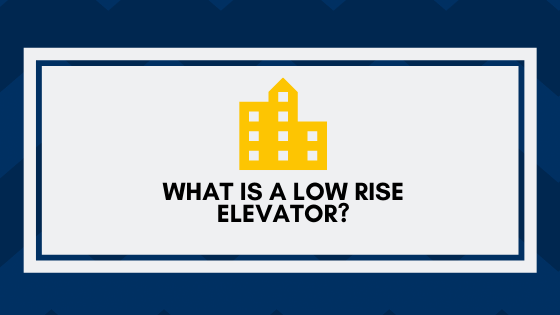
Low rise elevators are primarily used for low-rise applications of 2-8 stories and can travel at a maximum speed of 200 feet per minute. The machine room for hydraulic elevators is located at the lowest level adjacent to the elevator shaft.
There are several types of elevators that act as devices to move people and goods vertically within a dedicated shaft that connects the floors of a building. Elevators started to become commonplace in the late 1800’s once steel and iron structural frames allowed taller construction.
However, it was Elisha Otis’s safety mechanism that prevented the car from falling that made elevators safer and more reliable. The majority of modern multi-floor buildings have elevators that are required to provide universal access.
There are three main types of elevators commonly used: traction with a machine room, machine-room-less traction, and hydraulic; however, there are variations on each type.

Hydraulic Elevators
Hydraulic elevators are supported by a piston at the bottom of the elevator that pushes the elevator up as an electric motor forces oil or another hydraulic fluid into the piston. The elevator descends as a valve releases the fluid from the piston. They are used for low-rise applications of 2-8 stories and travel at a maximum speed of 200 feet per minute. The machine room for hydraulic elevators is located at the lowest level adjacent to the elevator shaft.
Conventional Hydraulic Elevators have a sheave that extends below the floor of the elevator pit, which accepts the retracting piston as the elevator descends. Some configurations have a telescoping piston that collapses and requires a shallower hole below the pit. Max travel distance is approximately 60 feet.

Hole-less Hydraulic Elevators
Hole-less Hydraulic Elevators have a piston on either side of the cab. In this configuration, the telescoping pistons are fixed at the base of the pit and do not require a sheave or hole below the pit. Telescoping pistons allow up to 50 feet of travel distance. Non-telescoping pistons only allow about 20 feet of travel distance.

Roped Hydraulic Elevators
Roped Hydraulic Elevators use a combination of ropes and a piston to move the elevator. Maximum travel distance is about 60 feet.
Hydraulic elevators can have a low initial cost and their ongoing maintenance costs are minimal compared to the other types of elevators. However, hydraulic elevators use more energy than other types of elevators because the electric motor must compete with gravity as it forces hydraulic fluid into the piston.
One of the drawbacks of hydraulic elevators is that the hydraulic fluid can sometimes leak, which can cause a serious environmental hazard. The environmental risk and high energy use are two main reasons that hydraulic elevators are not being installed as often as in the past.

Island Elevator is Ready to Help!
Island Elevator is here to help you understand all facets of your Elevator Repair, Maintenance, & Modernization costs in the new year. Our team is here to help ensure your home and business vertical transportation equipment receive the regularly scheduled maintenance necessary to help you avoid a major catastrophe, reduce the possibility of a costly repair, and ensure the safety of your passengers, tenants, and family.

